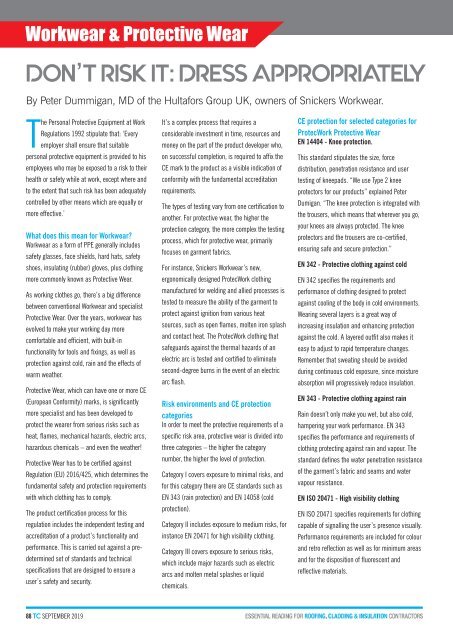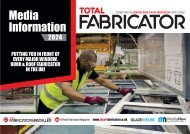September 2019
You also want an ePaper? Increase the reach of your titles
YUMPU automatically turns print PDFs into web optimized ePapers that Google loves.
Workwear<br />
SPONSORED BY<br />
& Protective Wear<br />
DON’T RISK IT: DRESS APPROPRIATELY<br />
By Peter Dummigan, MD of the Hultafors Group UK, owners of Snickers Workwear.<br />
The Personal Protective Equipment at Work<br />
Regulations 1992 stipulate that: ‘Every<br />
employer shall ensure that suitable<br />
personal protective equipment is provided to his<br />
employees who may be exposed to a risk to their<br />
health or safety while at work, except where and<br />
to the extent that such risk has been adequately<br />
controlled by other means which are equally or<br />
more effective.’<br />
What does this mean for Workwear?<br />
Workwear as a form of PPE generally includes<br />
safety glasses, face shields, hard hats, safety<br />
shoes, insulating (rubber) gloves, plus clothing<br />
more commonly known as Protective Wear.<br />
As working clothes go, there’s a big difference<br />
between conventional Workwear and specialist<br />
Protective Wear. Over the years, workwear has<br />
evolved to make your working day more<br />
comfortable and efficient, with built-in<br />
functionality for tools and fixings, as well as<br />
protection against cold, rain and the effects of<br />
warm weather.<br />
Protective Wear, which can have one or more CE<br />
(European Conformity) marks, is significantly<br />
more specialist and has been developed to<br />
protect the wearer from serious risks such as<br />
heat, flames, mechanical hazards, electric arcs,<br />
hazardous chemicals – and even the weather!<br />
Protective Wear has to be certified against<br />
Regulation (EU) 2016/425, which determines the<br />
fundamental safety and protection requirements<br />
with which clothing has to comply.<br />
The product certification process for this<br />
regulation includes the independent testing and<br />
accreditation of a product’s functionality and<br />
performance. This is carried out against a predetermined<br />
set of standards and technical<br />
specifications that are designed to ensure a<br />
user’s safety and security.<br />
It’s a complex process that requires a<br />
considerable investment in time, resources and<br />
money on the part of the product developer who,<br />
on successful completion, is required to affix the<br />
CE mark to the product as a visible indication of<br />
conformity with the fundamental accreditation<br />
requirements.<br />
The types of testing vary from one certification to<br />
another. For protective wear, the higher the<br />
protection category, the more complex the testing<br />
process, which for protective wear, primarily<br />
focuses on garment fabrics.<br />
For instance, Snickers Workwear’s new,<br />
ergonomically designed ProtecWork clothing<br />
manufactured for welding and allied processes is<br />
tested to measure the ability of the garment to<br />
protect against ignition from various heat<br />
sources, such as open flames, molten iron splash<br />
and contact heat. The ProtecWork clothing that<br />
safeguards against the thermal hazards of an<br />
electric arc is tested and certified to eliminate<br />
second-degree burns in the event of an electric<br />
arc flash.<br />
Risk environments and CE protection<br />
categories<br />
In order to meet the protective requirements of a<br />
specific risk area, protective wear is divided into<br />
three categories – the higher the category<br />
number, the higher the level of protection.<br />
Category I covers exposure to minimal risks, and<br />
for this category there are CE standards such as<br />
EN 343 (rain protection) and EN 14058 (cold<br />
protection).<br />
Category II includes exposure to medium risks, for<br />
instance EN 20471 for high visibility clothing.<br />
Category III covers exposure to serious risks,<br />
which include major hazards such as electric<br />
arcs and molten metal splashes or liquid<br />
chemicals.<br />
CE protection for selected categories for<br />
ProtecWork Protective Wear<br />
EN 14404 - Knee protection.<br />
This standard stipulates the size, force<br />
distribution, penetration resistance and user<br />
testing of kneepads. “We use Type 2 knee<br />
protectors for our products” explained Peter<br />
Dumigan. “The knee protection is integrated with<br />
the trousers, which means that wherever you go,<br />
your knees are always protected. The knee<br />
protectors and the trousers are co-certified,<br />
ensuring safe and secure protection.”<br />
EN 342 - Protective clothing against cold<br />
EN 342 specifies the requirements and<br />
performance of clothing designed to protect<br />
against cooling of the body in cold environments.<br />
Wearing several layers is a great way of<br />
increasing insulation and enhancing protection<br />
against the cold. A layered outfit also makes it<br />
easy to adjust to rapid temperature changes.<br />
Remember that sweating should be avoided<br />
during continuous cold exposure, since moisture<br />
absorption will progressively reduce insulation.<br />
EN 343 - Protective clothing against rain<br />
Rain doesn’t only make you wet, but also cold,<br />
hampering your work performance. EN 343<br />
specifies the performance and requirements of<br />
clothing protecting against rain and vapour. The<br />
standard defines the water penetration resistance<br />
of the garment’s fabric and seams and water<br />
vapour resistance.<br />
EN ISO 20471 - High visibility clothing<br />
EN ISO 20471 specifies requirements for clothing<br />
capable of signalling the user’s presence visually.<br />
Performance requirements are included for colour<br />
and retro reflection as well as for minimum areas<br />
and for the disposition of fluorescent and<br />
reflective materials.<br />
88 TC SEPTEMBER <strong>2019</strong>

















